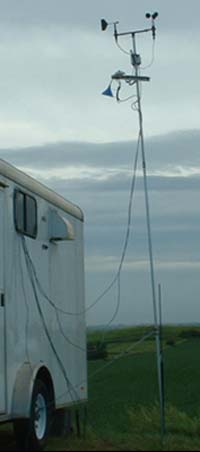



Nuisance Farm Odour is Target for ISU Researchers
Nuisance farm odour is the focus of the work of an Iowa State University (ISU) academics. Professor Hoff has led the development of a system for operating odour mitigation systems only when the weather conditions would lead them to affect neighbours.In the summer months, few people can afford to run their air conditioning 24 hours a day. And even if you could afford it, there are times during the day when you just do not need it.
Steven Hoff, an Iowa State University professor of agricultural and biosystems engineering, thinks the same logic should apply to odour mitigation for concentrated animal feeding operations. He has developed a system for operating odour mitigation systems only when the weather is most likely to cause the odours to become a nuisance to neighbours.

Professor Hoff's odour mitigation prototype monitors several climate variables and operates only when neighbours may be affected. The system is a miniature weather station that includes locations of neighbours as part of its programming.
He explained: "The idea is to keep track of atmospheric stability, which we know affects how far odours will travel, and whether a neighbour may be impacted because of the atmospheric conditions – the wind direction, and those types of things.
"But if no one is going to be impacted by the odours emitting from a pig house, let's say, or a poultry house, then save the farmer some money and don't mitigate."
Professor Hoff said the system can be used with any odour-scrubbing system that can be controlled in an on/off mode.
"Whatever the method is – bio-filters or any other mitigation technique – it will be turned on when the conditions dictate," he said.

The most important weather aspect of the system is monitoring atmospheric stability, according to Professor Hoff. When the atmosphere is unstable, odours will not travel as far and it will affect fewer neighbours. When the atmosphere is more stable, odours will travel farther and can be a nuisance to more neighbours, according to Hoff.
He said: "We call it 'impact-based odour control' because the idea is going to be to mitigate only when needed."
Atmospheric conditions that the system monitors most closely are humidity, wind speed, wind direction, temperature and solar impact – all of these are likely to affect stability.
Because two of the important inputs of the system are wind speed and direction, the system can also tell in which direction the odour may be heading.
Professor Hoff and Lun Tong, adjunct assistant professor in agricultural and biosystems engineering, currently can take into account the locations of five different neighbours. Within a year, the programme will be able to expand to as many as 20 neighbours that might be affected.
Another benefit of the system is the effect on emissions that have environmental impact.
"This is not geared to gas-emission reduction; however, one of the side benefits is that you are still mitigating some of the gases that have environmental concern," said Professor Hoff.
Through two summers of research, he and Professor Tong have developed a system that will provide "significant reduction in operation time while still maximising the benefit to the neighbour," and also be affordable for the producer, according to Professor Hoff.
Cost of operation is the greatest limiting factor for current odour mitigation systems, he said. This system will allow producers to invest greater amounts in the mitigation system without having to worry as much about operating costs.
For anyone who lives outside the city, there are trade-offs.
Professor Hoff concluded: "In my business, everybody has a sensor. And everyone's is calibrated a little differently. We all have thresholds. My wife's threshold is lower than mine. With this system, we are trying to minimise the odour impact of animal production to become less of a nuisance to neighbours."
March 2010











